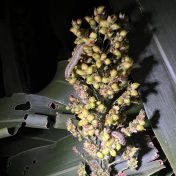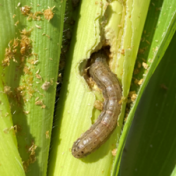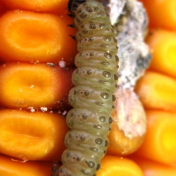Maize and sorghum crops across Queensland are experiencing extreme fall armyworm (FAW) pressure. In Central Queensland in particular, sorghum planted in the typical planting window has been heavily impacted by the very high FAW pressure. Persistent, high-density infestations pose a risk to crops from emergence through to grain fill. In an unwelcome development not observed in previous seasons, large FAW… Read more »
Fall armyworm (FAW) are still active across the Northern Grains Region, but inland Central and Southern Queensland have not experienced continuous population build up in crops since the first immigration of moths in September–October. One of the major contributors to this continuing low pressure is probably the very high natural enemy (beneficial) impact on FAW. A number of very common… Read more »
Recent reports were received of decidedly non-armyworm looking caterpillars attacking corn cobs in a crop near Mundubbera. The larvae in question were pale with lines of large dark spots on their back, and looked very similar to a serious mungbean pest, beanpodborer (Maruca vitrata). However, the larvae in question were slightly larger (about 20 mm) and some had a slight… Read more »
Emerging and vegetative summer crops in close proximity to unharvested winter crop are at risk of thrip damage, but the damage is largely cosmetic and rarely warrants treating. Thrips breed up in winter cereals, and particularly after rain, will move out of the winter crops in huge numbers. Most of you will be familiar with the joys of thrips biting… Read more »
Where there is a history of soil insect damage resulting in poor crop establishment a pre-sowing inspection of the affected fields is warranted to determine the likely risk to the upcoming summer crop. Grain baits are an effective way of monitoring for soil-dwelling insect pests of summer crops, and is preferable to sampling with a shovel, which is both time… Read more »
On the Darling Downs there have been a number of reports of common armyworm causing significant defoliation in sorghum, corn and millet. Jimbour grower John Alexander treated a severely defoliated sorghum crop two weeks ago. Millet and corn crops in the same area have also been affected. Although patchy, the outbreaks have the potential to cause significant yield loss if… Read more »
Helicoverpa populations have started with a bang this season. One or more larvae per plant are common in pre-flowering sorghum, corn and cotton. However, early flowering sorghum crops are carrying up to 10 larvae per head. Corn and sorghum (monocot crops) host only Helicoverpa armigera, not H. punctigera – which has implications for control. Some key issues relevant to dealing… Read more »
However, in some years, very high pest activity results in more severe cob damage, with larvae often tunnelling into the sides of cobs. In such cases grain samples may contain fungus-affected grains and mycotoxins, causing a downgrade in the quality of harvested grain.



